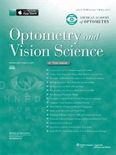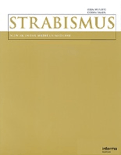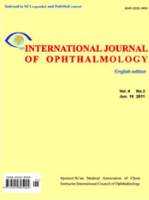
OPTOMETRY AND VISION SCIENCE
Scope & Guideline
Advancing Eye Care Through Scientific Excellence
Introduction
Aims and Scopes
- Clinical Practice and Research in Optometry:
The journal features studies related to clinical practices in optometry, including the assessment and management of various ocular conditions, refractive errors, and visual impairments. - Myopia Management and Research:
There is a significant focus on myopia, encompassing research on its epidemiology, progression, interventions, and management strategies, reflecting the growing concern over global myopia rates. - Innovative Technologies in Vision Science:
The journal highlights advancements in optical technologies, including the development and evaluation of diagnostic tools, treatment devices, and digital health interventions for vision care. - Vision Rehabilitation and Low Vision:
Research related to rehabilitation strategies for individuals with vision impairments, including the effectiveness of assistive devices and interventions to improve quality of life. - Public Health and Epidemiology of Vision Disorders:
The journal addresses public health implications of vision disorders, including epidemiological studies that assess risk factors, prevalence, and socio-economic impacts. - Ocular Pathology and Disease Mechanisms:
Studies exploring the underlying mechanisms of ocular diseases, including age-related conditions, diabetic retinopathy, and other retinal disorders. - Patient-Centered Care and Quality of Life:
Research focusing on patient experiences, preferences, and the impact of vision disorders on quality of life, emphasizing the importance of patient-centered approaches in optometry.
Trending and Emerging
- Artificial Intelligence and Machine Learning in Vision Science:
There is a growing trend towards utilizing AI and machine learning for diagnostic purposes and patient management, reflecting the integration of technology in clinical practice. - Teleoptometry and Remote Patient Management:
Emerging research on telehealth solutions for optometry is gaining traction, especially in light of the COVID-19 pandemic, highlighting the importance of remote patient care and accessibility. - Behavioral and Environmental Factors in Myopia Development:
Recent studies are increasingly focusing on the role of lifestyle, environmental influences, and behavioral factors in the development and progression of myopia, reflecting public health concerns. - Vision and Cognitive Function:
Research linking vision health to cognitive outcomes and functioning is emerging, emphasizing the interconnectedness of visual and cognitive health, particularly in aging populations. - Interdisciplinary Approaches to Vision Rehabilitation:
There is a trend towards interdisciplinary research that combines optometry with other health disciplines to develop holistic rehabilitation strategies for individuals with vision impairments. - Sustainability in Eye Care Practices:
An increasing number of articles address sustainable practices within the field of optometry, reflecting a broader societal push towards environmental consciousness.
Declining or Waning
- Traditional Refractive Error Correction Techniques:
There appears to be a waning interest in studies solely focused on traditional methods of refractive error correction, such as spectacles and basic contact lenses, as newer technologies and myopia management strategies gain prominence. - Basic Visual Acuity Assessments:
Research centered exclusively on standard visual acuity tests, without integration of advanced diagnostic tools or patient-centered outcomes, is becoming less frequent as the field moves towards comprehensive assessments. - Historical Perspectives on Optometry:
The journal has seen a decrease in the publication of historical analyses of optometry, as contemporary issues and innovations take precedence over retrospective studies. - Generalized Studies on Eye Health Disparities:
While eye health disparities remain important, generalized studies without targeted interventions or specific population studies are appearing less frequently, indicating a shift towards more focused and actionable research.
Similar Journals

Strabismus
Connecting Researchers and Clinicians for Eye Health ExcellenceStrabismus is a distinguished journal published by Taylor & Francis Inc, dedicated to the field of ophthalmology, with a focus on the diagnosis, treatment, and research surrounding strabismic conditions. Since its inception in 1993, this journal has served as a pivotal platform for advancing knowledge and fostering discussion among researchers and clinicians alike, providing critical insights into the complexities of eye alignment disorders. With a current impact factor reflecting its solid standing in the Q3 quartile of ophthalmology journals, Strabismus continues to rank among the notable publications in its field, achieving a Scopus rank of #85 out of 137. Although it operates without an open access model, the journal is accessible to a broad audience of professionals through institutional subscriptions, ensuring that a wealth of research is available to support clinical practices. By encompassing a wide range of topics, from clinical studies to theoretical analyses, Strabismus aims to enhance understanding and improve patient outcomes, making it an essential resource for those engaged in ocular health and research.

OPHTHALMIC AND PHYSIOLOGICAL OPTICS
Bridging research and practice in visual health.Ophthalmic and Physiological Optics, published by Wiley, is a premier peer-reviewed journal dedicated to advancing the fields of ophthalmology, optometry, and sensory systems. With an impressive impact factor and categorized in the prestigious Q1 quartile for 2023 across multiple disciplines, the journal provides a vital platform for researchers and practitioners to disseminate innovative findings and explore the complexities of visual science. Founded in 1981, it continues to thrive as a leading resource for reviewing contemporary issues, emerging technologies, and clinical practices. Readers will benefit from its rigorous editorial standards and access to groundbreaking studies pertinent to both academic and clinical environments. Situated at the forefront of the discipline, Ophthalmic and Physiological Optics plays an essential role in bridging the gap between research and practical application, ensuring a comprehensive understanding of vision and its physiological underpinnings.

SURVEY OF OPHTHALMOLOGY
Fostering Scholarly Discourse in OphthalmologySURVEY OF OPHTHALMOLOGY is a premier journal published by Elsevier Science Inc, dedicated to advancing knowledge in the field of ophthalmology. With an impact factor reflective of its high-quality research—ranking 7th out of 137 in the Scopus category for medicine and ophthalmology, this journal maintains a prestigious Q1 categorization in its field for 2023. Since its inception in 1956, the journal has provided comprehensive reviews and original articles covering various aspects of ophthalmic research and clinical practice, supporting the ongoing education of researchers, professionals, and students alike. While open access options are not available, the journal remains an essential resource for the latest developments, discoveries, and expert insights that shape the future of eye health. Based in the United States, at STE 800, 230 Park Ave, New York, NY 10169, the journal continues a legacy of excellence in ophthalmology until 2024 and beyond, making it a pivotal element of scholarly discourse in this vital medical discipline.

EUROPEAN JOURNAL OF OPHTHALMOLOGY
Advancing Eye Health Through Innovative ResearchThe EUROPEAN JOURNAL OF OPHTHALMOLOGY, published by SAGE PUBLICATIONS LTD, is a leading international journal in the field of ophthalmology, dedicated to advancing the understanding and treatment of ocular diseases and disorders. With an ISSN of 1120-6721 and an E-ISSN of 1724-6016, the journal aims to provide a platform for innovative research, critical reviews, and comprehensive studies that span the diverse aspects of the discipline. As part of its commitment to disseminating high-quality research, the journal is indexed in Scopus, achieving an impressive rank of #47 out of 137 in the Medicine - Ophthalmology category, indicating its strong impact within the academic community. With a current impact factor that places it in the Q2 quartile for both Medicine (miscellaneous) and Ophthalmology as of 2023, it offers researchers and practitioners access to important findings and developments in eye health. The journal's converged years from 1991 to 2024 exemplify its longstanding commitment to the field, making it an essential resource for anyone looking to stay at the forefront of ophthalmological research.

JAMA Ophthalmology
Leading the Charge in Ophthalmic KnowledgeJAMA Ophthalmology, the premier journal in the field of ophthalmology, is published by the esteemed American Medical Association. Renowned for its rigorous peer-review process and commitment to advancing eye health research, JAMA Ophthalmology holds a prestigious position in the scientific community, boasting an impressive impact factor and ranking as Q1 in the category of Ophthalmology. With a Scopus rank of #3 out of 137 in its field and a remarkable 98th percentile, the journal serves as an invaluable resource for researchers, healthcare professionals, and students dedicated to the ophthalmic sciences. Readers can explore a wealth of cutting-edge findings, clinical studies, and review articles that not only contribute to the sustainable advancement of ophthalmic knowledge but also foster innovative approaches in patient care. As we converge into 2024, the journal continues to embrace open access principles, ensuring that groundbreaking research is readily available to a global audience, enhancing collaborative efforts and furthering the development of the ophthalmology discipline.

International Journal of Ophthalmology
Advancing Vision Through Innovative ResearchThe International Journal of Ophthalmology, with ISSN 2222-3959 and E-ISSN 2227-4898, is a premier open-access publication dedicated to advancing the field of ophthalmology. Published by IJO PRESS in China, this journal has been a valuable resource since its inception in 2005, providing a platform for groundbreaking research and clinical studies in ophthalmic science. With an impressive Q2 ranking in the 2023 Ophthalmology category and a Scopus rank of #65 out of 137, the journal consistently showcases high-quality articles that contribute significantly to the understanding and treatment of eye diseases. Since adopting an open-access model in 2010, it has expanded its reach, allowing researchers, professionals, and students worldwide to access vital knowledge in the field. The journal aims to bridge the gap between laboratory research and clinical practice, making it an essential resource for those committed to improving visual health and advancing ophthalmologic education and innovation.

Asia-Pacific Journal of Ophthalmology
Fostering collaboration for better eye health solutions.Asia-Pacific Journal of Ophthalmology is a distinguished open access journal published by the Asia-Pacific Academy of Ophthalmology (APAO), specializing in the latest advancements and research in ophthalmology. Since its inception in 2013, this journal has established itself as a vital platform for disseminating innovative findings and clinical practices across the Asia-Pacific region and beyond. With an impressive Scopus ranking of #10 out of 137 in the field of Medicine (Ophthalmology), placing it in the 93rd percentile, it garners significant attention and respect within the academic community. Currently holding a Q1 categorization in both Medicine (miscellaneous) and Ophthalmology, the journal embraces a broad scope that encompasses clinical studies, experimental research, and reviews aimed at enhancing the understanding and management of eye health. Its open access model since 2019 ensures that all published works are freely accessible, promoting greater collaboration and knowledge sharing among researchers, clinicians, and students. Situated in the Netherlands with a prominent address in Hong Kong, the journal serves as an essential resource for anyone dedicated to the field of ophthalmology.

VISUAL NEUROSCIENCE
Transforming Perception Through NeuroscienceVISUAL NEUROSCIENCE is a distinguished journal dedicated to advancing the understanding of visual processing through neuroscientific research. Published by Cambridge University Press and indexed in Scopus, this journal emphasizes the latest experimental and theoretical insights into the neurological basis of vision. Since its inception in 1988, VISUAL NEUROSCIENCE has effectively contributed to the field, showcasing high-quality research and innovative findings. Although it currently sits in the Q3 and Q4 quartiles for Physiology and Sensory Systems respectively, its commitment to rigorous research has allowed it to maintain relevance in a diverse array of scientific disciplines. Researchers, professionals, and students alike will find value in its comprehensive articles that explore the complexities of visual perception and associated neural mechanisms. The journal does not offer open access options, enhancing the exclusivity of its researched content. Set against the backdrop of Cambridge, England, VISUAL NEUROSCIENCE stands as an essential platform for the dissemination of knowledge in the vibrant field of visual neuroscience.

Journal of Optometry
Advancing vision science for a brighter future.The Journal of Optometry, published by Elsevier, is a leading open access journal dedicated to advancing the field of optometry and vision science. With an ISSN of 1888-4296 and an E-ISSN of 1989-1342, this journal serves as a pivotal platform for researchers, practitioners, and academics alike to disseminate and engage with high-quality original research and review articles. As of 2023, the journal holds an impressive Q2 ranking in the Optometry category, demonstrating its influence and relevance, particularly as it ranks #2 out of 12 in the Health Professions - Optometry category on Scopus with an 87th percentile. Since becoming open access in 2008, the Journal of Optometry has prioritized accessibility and the exchange of ideas, enriching the scholarly community and enhancing practical application in clinical settings. The journal welcomes submissions that push the boundaries of ocular research, clinical practices, and the education of optometry professionals, making it an essential resource for anyone invested in the future of eye health.

JOURNAL OF AAPOS
Advancing pediatric eye care through innovative research.The JOURNAL OF AAPOS, published by MOSBY-ELSEVIER, is a leading periodical dedicated to advancing knowledge in the fields of Ophthalmology and Pediatrics. With an ISSN of 1091-8531 and E-ISSN 1528-3933, this esteemed journal has been a critical resource for researchers and clinicians since its inception in 1997, continuing through to 2024. Recognized for its pivotal contributions, the journal holds a commendable Q2 ranking in both the Ophthalmology and Pediatrics, Perinatology and Child Health categories as of 2023, reflecting its impact within these essential medical disciplines. Although it operates under a subscription model, the journal consistently delivers high-quality peer-reviewed research articles that push the boundaries of clinical practice and education. Researchers, healthcare professionals, and students rely on the JOURNAL OF AAPOS for insightful studies, clinical guidelines, and innovative practices that aim to enhance patient care and outcomes in pediatric ophthalmology.